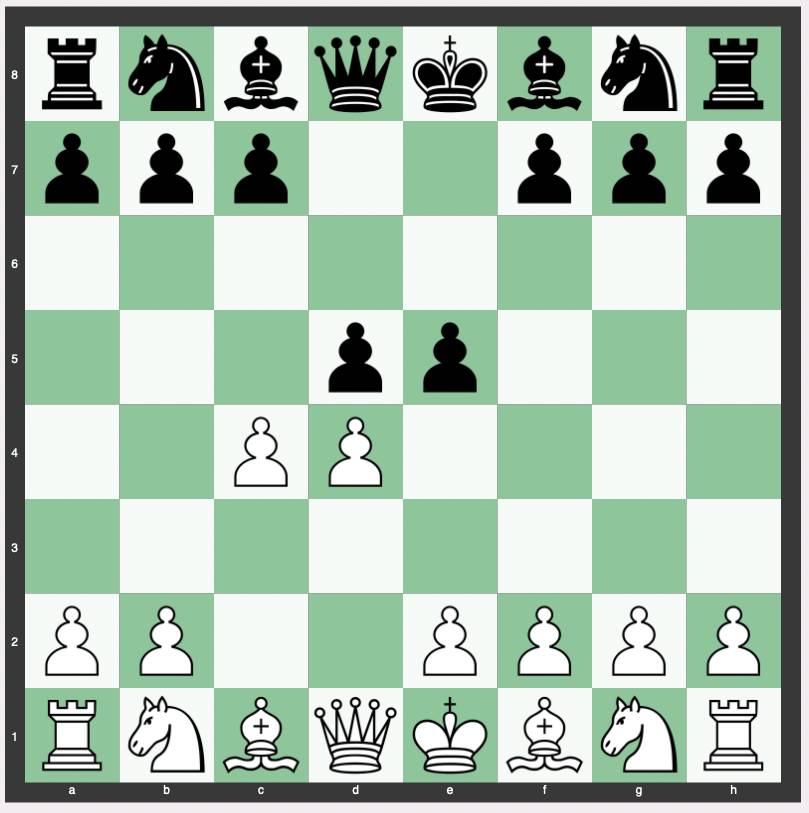The Albin Countergambit is an intriguing and at times controversial chess opening that offers a unique set of opportunities and challenges for both White and Black.
It begins with the moves 1. d4 d5, 2. c4 e5, with the usual continuation 3. dxe5 d4.
As a response to the Queen’s Gambit, it’s a choice that sacrifices a pawn to achieve an aggressive central presence.
Below we look into the various aspects of this opening, including its move order, theory, variations, history, suitability for different levels of players, and its frequency of play at the grandmaster level.
Move Order of the Albin Countergambit
- d4 d5
- c4 e5

And usually following with 3. dxe5 d4

These initial moves define the Albin Countergambit, an uncommon response to the Queen’s Gambit.
After these moves, the central wedge at d4 gives Black attacking chances.
Theory, Strategy, and Purpose of the Albin Countergambit
In the Albin Countergambit, Black sacrifices a pawn to gain a strong central wedge at d4.
This creates opportunities for an attack. White often seeks to return the pawn at a convenient moment to gain a positional advantage.
The pawn sacrifice sets up dynamic possibilities and can lead to complex middlegame positions.
It is a high-risk, high-reward strategy that often leads to an exciting game.
Evaluation of the Albin Countergambit
The Albin Countergambit (including the typical continuation) is evaluated at +1.00, favoring white.
Variations of the Albin Countergambit
Main Line
The main line continues with 4.Nf3 Nc6.

Main Line – 1. d4 d5 2. c4 e5 3. dxe5 d4 4. Nf3 Nc6
There are several options for White, with 5.g3 followed by Bg2 and Nbd2 being a common plan.
A typical continuation is 5.g3 Be6 6.Nbd2 Qd7 7.Bg2 0-0-0 8.0-0 Bh3.
Lasker Trap
The Lasker Trap can arise after 3.dxe5 d4 if White plays carelessly with 4.e3?
This trap is remarkable for featuring an underpromotion in practical play, leading to a winning position for Black.
Spassky Variation
The Spassky Variation involves White advancing with 4.e4 to avoid the Lasker Trap.
Minev’s analysis suggests that Black can achieve a better game after 4.e4? Nc6!
History of the Albin Countergambit
Originally played by Cavallotti against Salvioli in 1881, the Albin Countergambit is named after Adolf Albin, who employed it against Emanuel Lasker in 1893.
Though not a frequent choice at the master level, Alexander Morozevich, a Russian grandmaster, has made successful use of this opening in the 2000s.
Is the Albin Countergambit Good for Beginners or Intermediates?
The Albin Countergambit can be an engaging choice for intermediate players looking for an aggressive and unconventional response to the Queen’s Gambit.
For beginners, understanding the complexities of the pawn sacrifice and the ensuing middlegame might be challenging.
It requires a certain level of experience and risk tolerance to be played effectively.
CRUSH The Queen’s Gambit in 6 Moves: THE ALBIN
How Often Is the Albin Countergambit Played at the Grandmaster Level?
While not a common choice at the grandmaster level, the Albin Countergambit has seen some use, particularly by players known for their unconventional approaches.
Grandmaster Alexander Morozevich’s successful adoption of this opening in the 2000s is a notable example.
However, it is far from a mainstream choice among the elite players.
Conclusion
The Albin Countergambit is a fascinating opening that offers both risks and rewards.
Its unusual pawn sacrifice leads to exciting positions, but it requires a deep understanding of the ensuing complexities.
With a rich history, intriguing variations, and a place within the chess arsenals of some creative grandmasters, it continues to be a valuable part of the chess landscape.
Its suitability for intermediate players makes it an engaging option for those looking to explore beyond conventional paths.
Whether it’s the historical allure, the sharp variations, or the unconventional strategic concepts, the Albin Countergambit invites players to take a unique journey on the chessboard.


